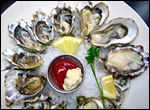
State and federal officials have spent $58 million since 1994 trying to make Chesapeake Bay a welcoming place for oysters — and it all seems to have been for naught. There are less bivalves in the bay now than there were in the mid-’90s, and the Maryland and Virginia oyster industries have declined in turn. Officials say they’re up against numerous factors, including disease that wipes out oysters by the millions and oyster-choking dirt that washes from lawns and fields. But critics say some modes of attempted recovery have been ineffective; for example, healthy oysters are often uprooted and moved to be easily accessible by oyster-catchers, and are thus more likely to be slurped off the half-shell than to reproduce. As for next steps, suggestions vary wildly: from rassling up more funding, to importing a different oyster species, to allowing even greater catches of wild oysters, to exclusively relying on oyster farms.

